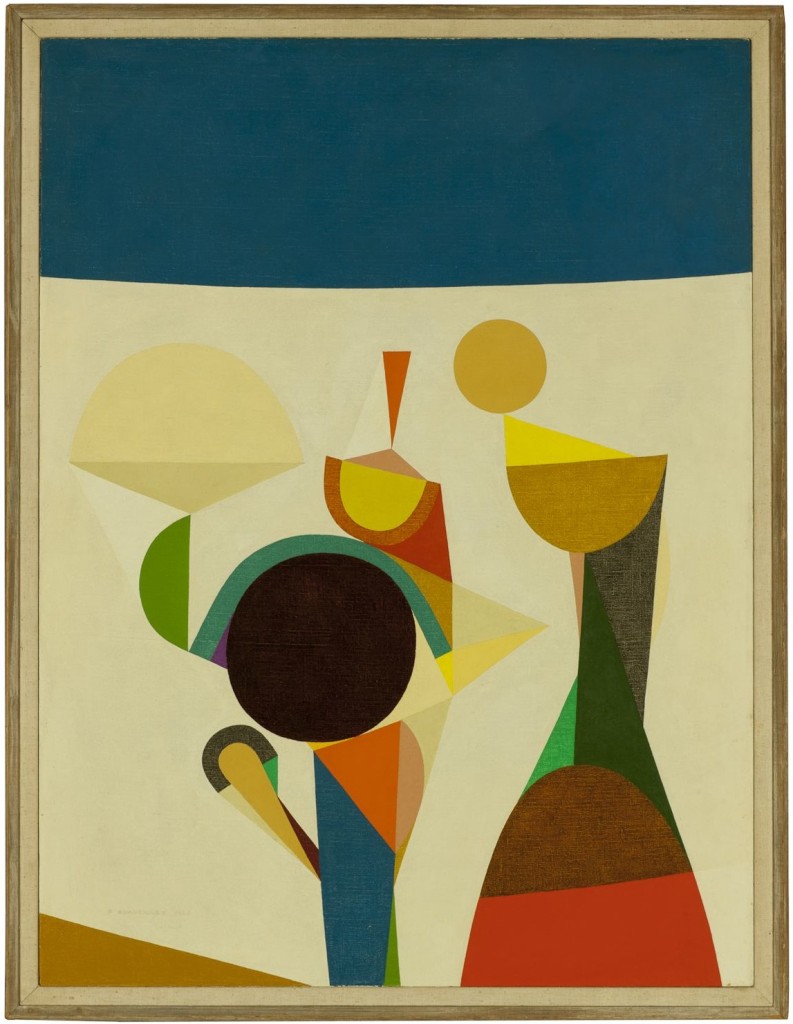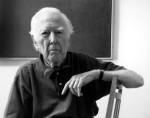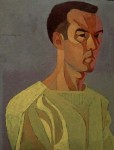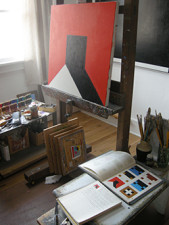

Fredrick Hammersley
American, 1919-2009
Growing game, 1958
oil on canvas
40 x 30 in.
SBMA, Museum purchase with funds provided by an Anonymous Donor and the Ludington Antiquities Fund
2012.24

Self Portrait, 1950, oil on CB panel, 23 x 18 in., Collection of the Albuquerque Museum of Art and History, New Mexico

Notebooks and unfinished painting set up in Frederick Hammersley's studio in March 2012.
COMMENTS
Frederick Hammersley’s paintings are abstract, richly colored and possess a quietly resolute determination. They do not represent anything in the traditional sense; rather they suggest complex emotional states and patterns of thought. Their seemingly clear and simple compositions belie their pictorial richness.
Hammersley’s abstractions came out of drawing. While teaching at Jepson Art School in Los Angeles, he found “a delicious stone” to create intimate lithographic prints (each 3 x 3 inches) based on a grid structure of sixteen squares. He introduced compositional elements one by one, altering line, form, color, etc. to discover how each would react to the other. These small prints held the seeds for his later geometric paintings. After leaving Jepson in 1951, Hammersely recalled that he “bumped into hunch painting by accident,” inspired by the shapes that he saw in the figure and in still-life, reducing them to elemental form. These were intuitively derived compositions that gained the attention of curator, Jules Langsner, who included Hammersley in the landmark 1959 exhibition, Four Abstract Classicists, at the Los Angeles County Museum of Art. The show placed Hammersley’s work in the company of paintings by Karl Benjamin, Lorser Feitelson and John McLaughlin, and later traveled to the San Francisco Museum of Art; ICA, London, England; and Queen’s University, Belfast, Ireland. A rare hunch painting entitled Growing game, 1958, will be included in L.A. Louver’s exhibition.
Nineteen sixty-four was a particularly prolific year for Hammersley, as a series of organic abstractions emerged from the studio alongside geometric compositions. However, as the decade progressed, the geometrics increasingly consumed Hammersley’s attention: He first worked out his ideas as small sketches in a notebook, which he then executed in oil on canvas using a palette knife. Through this process, he created a symmetrical framework within which he built and balanced positive and negative space in a variety of eye-catching visual inversions. The cool forms and apparent hard lines (which he painted free-hand, without the aid of tape) are counterbalanced by a sense of wit, whimsy and easy virtuosity.
With the onset of the 1980s, Hammersely turned his attention to the emotionally driven organic abstractions. These emerged in a smaller format than those of the 1960s, and rarely exceeded 12 x 14 inches framed. The forms are not intended to evoke specific shapes, but exist autonomously. Gentle cupping lines, an expanded palette range, and clear evidence of brush strokes are their hallmarks. And, as with all the paintings, each was complete only when he had selected a title – often a pun or double entendre – that Hammersley considered a “wedge into the painting.”
Born in Salt Lake City in 1919, Hammersley studied art in San Francisco, and later in Los Angeles at the Chouinard Art Institute. In 1942, he was drafted into the army, but returned to the US in 1946 to resume his studies, subsidized by the GI Bill. Hammersley went on to teach (at Jepson, Pomona College, Pasadena Art Museum and Chouinard), and throughout the 1960s exhibited widely in California, with solo shows at the Pasadena Art Museum, 1961; the California Palace of the Legion of Honor, San Francisco and Occidental College, Los Angeles, 1962; and the La Jolla Museum of Art, 1963. In 1968, Hammersley accepted a teaching post at the University of New Mexico in Albuquerque, and while he stayed at the university for only three years, remained in Albuquerque until his death in 2009.
From the 1970s through the 1990s, Hammersley’s presence in L.A. was rare. However, with the exhibition I’ve Been Here all the While at L.A. Louver in 2000, coupled with a retrospective that traveled from the Museum of Fine Arts, Boston, MA, and the Laguna Art Museum, Laguna Beach, CA in 1999-2000, a national audience re-engaged with Hammersley’s work. Hammersley’s inclusion in Beau Monde: Toward a Redeemed Cosmopolitanism at Site Santa Fe in 2002, and The Los Angeles School of Painting: Karl Benjamin, Lorser Feitelson, Frederick Hammersley, June Harwood, Helen Lundeberg and John McLaughlin, 2004-2005 at the Ben Maltz Gallery, Otis College of Art and Design, both curated by Dave Hickey, further augmented his reputation. Pomona College Museum of Art’s Hunches, Geometrics, Organics: Paintings by Frederick Hammersley, in 2007, was Hammersley’s last solo museum exhibition before he died in 2009.
A 112-page, fully illustrated, hardbound catalogue, with a foreword by Peter Goulds and essay by Elizabeth East, is published in conjunction with the exhibition.
- Artweek.LA, March 19, 2012
SBMA CURATORIAL LABELS
Frederick Hammersley, along with Karl Benjamin, Lorser Feitelson, and John McLaughlin, was included in the landmark exhibition Four Abstract Classicists in 1959 at the Los Angeles County Museum of Art. Curator Jules Langsner brought the four artists together to assert a distinctively Southern Californian style of abstraction. The cool flatness of their work, dubbed “hard-edge,” offered a counterpoint to the emotive gestures of New York Abstract Expressionism. Langsner commented, “Frederick Hammersley presents a poetic attitude towards shapes as growing things.”
Growing game is a painting from Hammersley’s “Hunch” series, which he began in 1950. His process would begin with a shape for which he intuitively chose a color and then proceeded to complete the work by adding shapes and colors by “feeling,” or “hunch.”
- Ridley-Tree Gallery 2016
